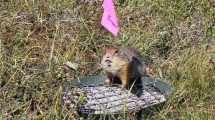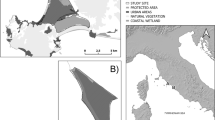Abstract
Short glides of less than 20 m seem energy inefficient for the Siberian flying squirrel Pteromys volans as with the northern flying squirrel Glaucomys sabrinus. However, Siberian flying squirrels in low-canopy forests frequently use short glides. Therefore, we sought to clarify the gliding patterns of Siberian flying squirrels for energy-efficient gliding transport in low-canopy forests (mean tree height, 15.3 m) in Hokkaido, Japan, based on records of 66 glides and 35 launch and landing trees. Mean launch height, landing height, and horizontal glide distance were 14.4, 2.7, and 21.4 m, respectively. For short distances, horizontal glide distance was strongly correlated with launch heights but not with launch tree height. For glides of more than 20 m, horizontal glide distance was significantly correlated with both launch height and launch tree height. The mean heights of launch and landing trees for short glides were 15.6 and 19.5 m, respectively. For long glides, these heights were 22.7 and 19.2 m. For short glides, mean launch tree height did not differ from overall mean tree height. However, for long glides, the mean launch tree height was greater than the overall mean tree height. Also, for short glides, the height of the landing tree was greater than that of the launch tree. Launch trees used for long glides were as high as the landing trees used in short glides. From these results, we conclude that Siberian flying squirrels in low-canopy forests save energy by gliding initially from a tree with sufficient height to permit a glide to a taller tree. This taller tree then permits long-distance glides that are energetically more efficient.




Similar content being viewed by others
References
Ando M, Shiraishi S (1993) Gliding flight in the Japanese giant flying squirrel Petaurista leucogenys. J Mammal Soc Jpn 18:19–32
Asari Y, Yanagawa H (2009) Movement of the Siberian flying squirrel, Pteromys volans orii, in fragmented small woods. Biosph Conservat 9:13–17
Asari Y, Yanagawa H, Oshida T (2007) Gliding ability of the Siberian flying squirrel Pteromys volans orii. Mamm Stud 32:151–154
Ball TM, Goldingay RL (2008) Can wooden poles be used to reconnect habitat for a gliding mammal? Landsc Urban Plann 87:140–146
Byrnes G, Lim NT-L, Spence AJ (2008) Take-off and landing kinetics of free-ranging mammal, the Malayan colugo (Galeopterus variegatus). Proc R Soc B 275:1007–1013
Byrnes G, Lim NT-L, Yeong C, Spence AJ (2011) Sex differences in the locomotor ecology of a gliding mammal, the Malayan colugo (Galeopterus variegatus). J Mammal 92:444–451
Dzulhelmi MN, Abdullah MT (2009) An ethogram construction for the Malayan flying lemur (Galeopterus variegatus) in Bako National Park, Sarawak, Malaysia. J Trop Biol Conserv 5:31–42
Essner RL Jr (2007) Morphology, locomotor behaviour and microhabitat use in North American squirrels. J Zool (Lond) 272:101–109
Flaherty EA, Scheibe JS, Goldigay R (2008) Locomotor performance in the squirrel glider, Petaurus norfolcensis, and the sugar glider, Petaurus breviceps. Aust Mamm 30:25–35
Goldingay RL (2000) Gliding mammals of the world: diversity and ecological requirements. In: Goldingay R, Scheibe J (eds) Biology of gliding mammals. Filander Verlag, Fürth, pp 9–44
Goldingay RL, Taylor BD (2009) Gliding performance and its relevance to gap crossing by the squirrel glider (Petaurus norfolcensis). Aust J Zool 57:99–104
Hanski IK, Monkkonen M, Reunanen P, Stevens P (2000) Ecology of the Eurasian flying squirrel (Pteromys volans) in Finland. In: Goldingay R, Scheibe J (eds) Biology of gliding mammals. Filander Verlag, Fürth, pp 67–86
Jackson SM (2000) Glide angle in the genus Petaurus and a review of gliding in mammals. Mamm Rev 30:9–30
Mendoza MM, Custodio CC (2000) Field observations on the Philippine flying lemur (Cynocephalus volans). In: Goldingay R, Scheibe J (eds) Biology of gliding mammals. Filander Verlag, Fürth, pp 273–280
Oshida T (2009) Rodentia Sciuridae Pteromys volans (Linnaeus, 1758). In: Ohdachi SD, Ishibashi Y, Iwasa MA, Saitoh T (eds) The wild mammals of Japan. Shoukadoh, Kyoto, pp 196–197
Scheibe JS, Robins JH (1998) Morphological and performance attributes of gliding mammals. In: Steele MA, Merritt JF, Zegers DA (eds) Ecology and evolutionary biology of tree squirrels. Virginia Museum of Natural History, Virginia, pp 131–144
Scheibe JS, Smith WP, Bassham J, Magness D (2006) Locomotor performance and cost of transport in the northern flying squirrel Glaucomys sabrinus. Acta Theriol 51:169–178
Selonen V, Hanski IK (2004) Young flying squirrels (Pteromys volans) dispersing in fragmented forests. Behav Ecol 15:564–571
Smith WP, Nichols V (2003) Demography of the Prince of Wales flying squirrel, an endemic of southeastern Alaska temperate rain forest. J Mammal 84:1044–1058
Stafford BJ, Thorington RW, Kawamichi T (2002) Gliding behavior of Japanese giant flying squirrels (Petaurista leucogenys). J Mammal 83:553–562
Stafford BJ, Thorington RW, Kawamichi T (2003) Positional behavior of Japanese giant flying squirrels (Petaurista leucogenys). J Mammal 84:263–271
Thorington RW Jr, Heaney LR (1981) Body proportions and gliding adaptations of flying squirrels (petauristinae). J Mammal 62:101–114
Vernes K (2001) Gliding performance of the northern flying squirrel (Glaucomys sabrinus) in mature mixed forest of eastern Canada. J Mammal 82:1026–1033
Wischusen EW (2000) The impact of gliding on the ecology of arboreal folivores. In: Goldingay R, Scheibe J (eds) Biology of gliding mammals. Filander Verlag, Fürth, pp 119–134
Zhaler P (2001) The woolly flying squirrel and gliding: does size matter? Acta Theriol 46:429–435
Acknowledgments
We thank Dr. T. Oshida and Dr. M. Takada at Obihiro University of Agriculture and Veterinary Medicine for their helpful comments on the manuscript. We also thank K. Ono, T. Kubo, M. Minoshima, and D. Yoshimatsu at Obihiro University of Agriculture and Veterinary Medicine for their support with the field observation. We are grateful to Mr. D. Campbell and Mr. G. Hill at Obihiro University at Agriculture and Veterinary Medicine for English proofreading of the manuscript.
Author information
Authors and Affiliations
Corresponding author
Additional information
Communicated by: Justin G. Boyles
Rights and permissions
About this article
Cite this article
Suzuki, K., Asari, Y. & Yanagawa, H. Gliding locomotion of Siberian flying squirrels in low-canopy forests: the role of energy-inefficient short-distance glides. Acta Theriol 57, 131–135 (2012). https://doi.org/10.1007/s13364-011-0060-y
Received:
Accepted:
Published:
Issue Date:
DOI: https://doi.org/10.1007/s13364-011-0060-y




